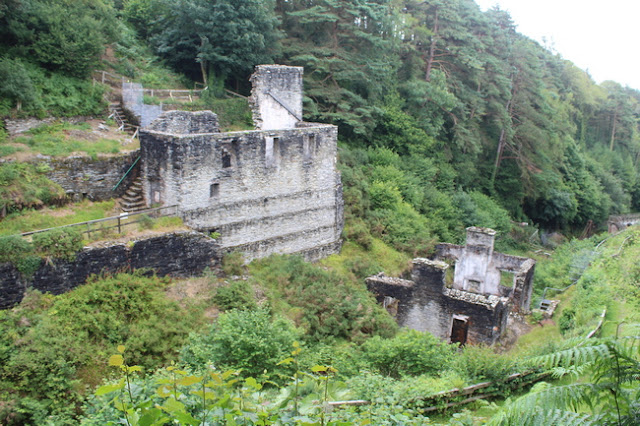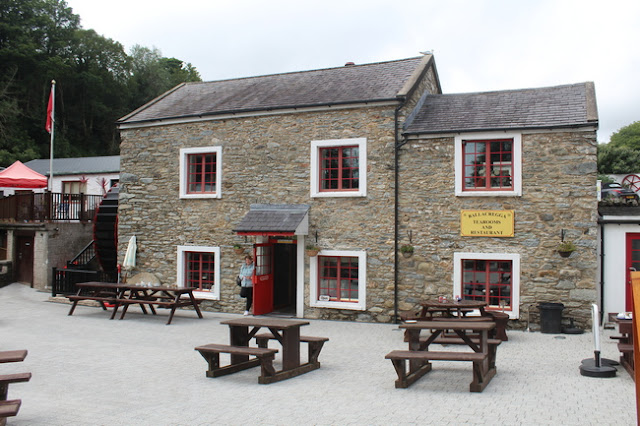Round trip from Laxey Tram Stop. Distance 3.2 Miles
The Laxey Wheel, the "Lady Isabella Wheel" is the largest working water wheel in the world and the best known landmark in the Isle of Man. It was built in 1854 and used to pump water from the Great Laxey Mine which mined lead and other metal ores. Water wheels were generally used in the early 18th Century until steam engines took over, though the Isle of Man didn't have it's own supplies of coal so water wheels were built here a century after they ceased to be fashionable.
Below - View of the wheel and the former miners' community around it from the Snaefell Mountain Railway.
Behind the grand wheel are the remains of the mines the wheel was built to drain. At its peak the mine produced as much lead ore as the rest of the UK put together.
Below - A view of the site of Snaefell Mine from the passing Snaefell Mountain Railway.
Starting at Laxey's tram stop on the Manx Electric Railway and the Snaefell Mountain Railway it's a short walk to the Washing Floor where the ore was processed. The dominant feature of the Washing Floor site is the "Lady Evelyn Wheel" a much smaller waterwheel that powered the machinery at the Washing Floor site.
Below - Image from Wikipedia showing the Washing Floor when the mine was in operation. The Lady Evelyn Wheel can be seen on the left.
On the upper right of the above photo a tunnel under the road and engine shed for the mines railway can be seen. The railway used two steam locos Ant and Bee, unfortunately these were scrapped in 1935 after the mine had closed. Part of the railway was revived in 2000 and replicas of Ant and Bee now operate between the Washing Floor and a station closer to the Lady Isabella Wheel and Mines Trail. Unlike coal mines where there are the dangers of flammable vapours, steam engines were able to operate in to the mines.
Below - The replica of Ant at the engine shed.

Below - Bee on one of the man rider cars used to carry passengers on the line.

Below - Clayton battery loco Wasp on some ore tubs.

The Great Laxey Mines Railway website
Below - Close to the far end of the line is a former mine entrance. With the wheel no longer pumping the mine dry it looks like a stream now.

Below - The Lady Isabella wheel.
Below - The viaduct that carries the rod from the wheel to the pump near the mine shaft.
Below - Counterweight for the rods. The barrel is now empty as the rods are disconnected.
Many visitors to the Laxey Wheel just visit the wheel but at either side of the wheel there are the signposted paths of the mines trail which visits the remains of other buildings associated with the mines around the Engine Shaft and Welsh Shaft.
Below - A map of the mines trail.
Below - On the east side of the wheel is the Old Adit Level which can be visited.
Below - On the west side of the wheel is a spare crank. It was planned to have rods on both sides of the wheel but rods on one side were sufficient and the spare crank was never used.
Below - A stone cistern. A nearby stream could be diverted to feed the wheel if the water levels were low.
Below - A conduit to the Machine House at the Engine Shaft. The machinery at the shaft could be powered by water power or steam power.
Below - Left to right the Engine House, Machine House and Conduit.
Below - The Engine House.
Below - The T Rocker, an inverted T shaped linkage that connected the rod from the wheel to the pump in the Engine Shaft.
Below - The Machine House.
Below - The Engine House and Machine House.
Below - The Welsh Shaft.
Below - The Compressor House at the end of the mines trail.
Below - Close to the entrance to the Laxey Wheel site a watermill can be seen. Nearby houses were used by the mine workers and a community around the mine housed many other trades to provide for the workers.
We walked to Laxey Harbour along Glen Road, the course of a waggonway that carried ore to the harbour for export.
Below - Warehouse on the harbour previously used to store coal for the machine house and containing offices for the mine's clerks.
Below - Laxey Harbour.





































No comments:
Post a Comment